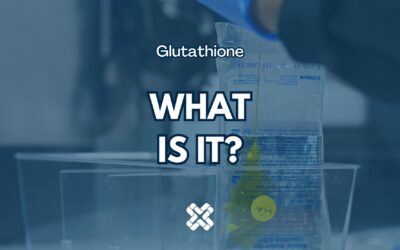Nutritional IV Therapy
Our unique IV’s can help everything from migraine relief to chronic fatigue by quickly, effectively supplying your cells with the vitamins, minerals, and amino acids they need.
Why Nutritional IV Therapy?
Nutrient IV therapy can be beneficial for those with medical conditions as well as individuals looking to improve their general health and wellness. When nutrients are given intravenously (through an IV), nearly 100% of those nutrients are available to your tissues and cells via your bloodstream.
This allows for optimal absorption, something that is not attainable with oral supplements due to the loss during digestion. IVs also get nutrients to your tissues at a much quicker rate than other forms of nutrient supplementation. This combination of quick and maximum absorption makes IV therapy one of the most effective ways to combat nutrient deficiencies and imbalances in your body.

Quickest, most effective way to supply your cells with the nutrients they need

Customized nutrient add-ons to target your specific health concerns

Detoxifies, boosts energy, relieves stress, and so much more
Request More Information:
Who can Nutritional IV Therapy Help?
Our IV’s have been shown to aid in the healing process of many conditions such as neurological disease, cardiovascular disease, joint and muscle pain and many more. They also have proven benefits for general health and wellness(1-5)! See the individual IV descriptions for details on which conditions our IVs can help improve.
- Amyotrophic Lateral Sclerosis (ALS)
- Boost Immunity
- Breast Cancer
- Chronic Fatigue Syndrome
- Fibromyalgia
- Health & Wellness
- Healthy Aging
- Lyme’s Disease
Nutritional IV Packages
Myers’ Cocktail IV
- The Myers’ Cocktail IV includes Magnesium, Calcium, Vitamin B Complex, additional Vitamin B5, B6, and B12, and Vitamin C. The effects of each component combine to offer a powerful nutrient IV with countless benefits.
- The Myers’ IV quickly relieves migraines, reduces joint and muscle pain, and decreases chronic inflammation(1, 6-8). It has amazing benefits for brain health, as it can improve conditions such as depression and anxiety as well as reduce cognitive decline. Lastly, the Myers’ IV has shown to reduces the risk of developing a number of diseases including cardiovascular disease and diabetes(2-4, 9-13) .
- ● Boosts Energy & Reduces Fatigue
- ● Decreases Chronic Inflammation
- ● Relieves Muscle & Joint Pain
- ● Improves Brain Health and Mental Health
NAD+ Trio IV
- All Extivtia NAD+ Trio IV’s include the Myer’s Cocktail IV and Glutathione IV to ensure our patients receive the full benefits of NAD+ infusion.
- Nicotinamide adenine dinucleotide (NAD+) is a “helper molecule” that plays a critical role in energy production, DNA repair, immune regulation, and gene expression(14). Unfortunately, NAD+ levels decrease with age and can lead to metabolic and mitochondrial dysfunction, thereby impairing normal functioning of cells and tissues(15-19).
- Diseases associated with NAD+ depletion include Alzheimer’s disease, cardiovascular diseases, diabetes and more(20-27). Thankfully, intravenous NAD+ can effectively raise NAD+ levels (28), providing both immediate benefits and potential protection from many chronic diseases.
- ● Increased energy and metabolism
- ● Promotes healthy brain function
- ● Reduces systemic inflammation
- ● Reduces risk of chronic, age-related diseases
Glutathione IV
- Glutathione is often called the “master antioxidant,” and for good reason. It protects cells from free-radical damage and drives detoxification by removing harmful pollutants, drugs, chemicals, and toxins from your body(29-30).
- It also reduces chronic inflammation, increases the functionality of the immune system, and even regenerates vitamins C and E (two other antioxidants)(30). Among the conditions that have shown dysregulation of glutathione are neurodegenerative, metabolic, chronic inflammatory, and inherited diseases(31).
- ● Protects Cells from Harmful Chemicals
- ● Reduces Chronic Inflammation
- ● Regenerates Vitamins C & E
- ● Vital to Energy and Metabolism
Asthma IV
- The asthma IV that we offer contains vitamin C, B complex, calcium, magnesium, and additional vitamins B5 and B6. Following the initial IV, we provide a vitamin B12 “push”, which is a smaller amount of concentrated B12 administered through the IV. Asthma is an inflammatory disease, and many of the vitamins and minerals in the IV are known to decrease inflammation(32). Combined with the B12 push, which is also anti-inflammatory, this IV works to decrease risk of asthma and reduce asthma symptoms(32-39).
- ● Anti-Inflammatory
- ● Reduces Symptoms of Asthma
- ● Reduces Risk of Asthma
Migraine IV
- The migraine IV contains magnesium and vitamin B6, both of which have proven benefits for relieving migraines. Magnesium has repeatedly been shown to reduce the frequency of migraines (how often they occur), as well as the severity of migraines(6, 7). Vitamin B6 reduces the severity and duration of migraines(40). Many patients report that the pain associated with their migraine is rapidly relieved following specialized migraine IV’s.
- ● Quickly Reduces Severity of Migraines
- ● Reduces Frequency of Migraines
- ● Reduces Duration of Migraines
Rehydration IV
- The rehydration IV is composed of saline solution. Because rehydration IV’s are delivered directly to the circulatory system, it bypasses normal absorption and quickly hydrates your body.
- These IV’s are common for dehydration, jet lag, and hangovers(41).
- ● Fixes Dehydration
- ● Reduces Jet Lag & Hangovers
High Dose Vitamin C IV
- The High Dose Vitamin C IV includes Vitamin C, Magnesium, Calcium, and Potassium. The effects of each component combine to offer a powerful nutrient IV with significant health benefits.
- High-dose vitamin C therapy acts as a non-toxic chemotherapeutic, antibacterial, and antiviral agent. At doses of 25 grams and higher, ascorbic acid can damage the DNA of cancer cells, bacteria, and viruses, resulting in cell death without harming normal, healthy cells.
- High Dose Vitamin C IV therapy provides the following benefits:
- ● Non-toxic Chemotherapeutic Agent
- ● Antiviral
- ● Antibacterial
Supercharger IV
- The Supercharger IV includes Vitamin C, Calcium, B Complex, Magnesium, Potassium, Taurine, Zinc, as well as Vitamin B5 and B6, with a Vitamin B12 “IV push” at the end of the infusion. The combined effects of these components create a robust nutrient IV with extensive benefits.
- Our Supercharger infusion is designed to rapidly replenish essential nutrients, enhance energy levels, and improve overall wellness. This potent blend supports immune function, boosts metabolism, and aids in muscle recovery, making it an excellent choice for those seeking a comprehensive health boost.
- Supercharger IV therapy provides the following benefits:
- ● Enhances Energy Levels
- ● Supports Immune Function
- ● Boosts Metabolism
- ● Aids Muscle Recovery
- ● Improves Overall Wellness
What are the Benefits of Nutritional IV Therapy?
Our nutrient IVs contain powerful combinations of nutrients that result in the benefits below. These benefits boost general feelings of wellbeing while simultaneously improving the symptoms of countless medical conditions.
- Boost Energy
- Boost Immunity & Treat Autoimmunity
- Decrease Pain & Inflammation
- Detoxification
- Improve Brain Function & Mental Clarity
- Relieve Stress & Anxiety
- Cold & Flu Remedy
- Support Athletic Performance & Recovery
- Hydration
- Migraine Relief
- Improve Overall Well-being

Frequently Asked Questions About Nutritional IV Therapy
Is Nutrient IV Therapy safe?
Nutrient IV Therapy is very safe. At Extivita, we use reputable and accredited compounding pharmacies for all of our IV components. Additionally, all IV bags and tubing are DEHP-free. Our experienced, licensed staff follow all standard safety protocols and procedures to minimize the risk of infection.
Are there any side effects to Nutrient IV Therapy?
Side effects from Nutrient IV Therapy rarely occur, if at all. If they do, they are typically minor and temporary. Bruising or bleeding at IV site, warming or cooling sensation in arm, chest, or stomach have been reported. Our staff are trained to manage all side effects that may occur.
How do I get started with Nutrient IV Therapy?
- New Patients: If you are a new patient and would like to receive nutrient IV’s, you will need to register as a patient on our website. You will then be given access to the patient portal, where you will fill in your medical history. Next step is to call (919) 354-3775 and schedule a consultation with our nurse practitioner. During this consult, we will review your current medical history and discuss how this therapy can be beneficial for you. We may require certain lab work prior to receiving nutrient IV therapy.
- Existing Patients: If you have already had a consultation for hyperbaric oxygen therapy, you will simply need a short consultation with our nurse practitioner to discuss how this therapy can be beneficial for you. There is no IV consultation charge for existing patients.
Do I need a prescription for Nutrient IV Therapy?
What happens after the IV Consultation?
After meeting with our provider and determining which Nutrient IV Therapies will optimize your health, you simply need to schedule your infusion at the front desk. That’s it!
Do I need to prepare for my infusion?
- We recommend that you come in hydrated (that you drank at least 2 glasses of water) prior to your appointment. This is even more important if you drink coffee as coffee can be a diuretic. Hydrated veins are easier to access!
- If you are coming in for an NAD+ infusion, please make sure to bring a snack because these infusions are 2-4 hours long. You might get hungry!
What should I expect during my infusion?
How often will I need treatments?
How soon will I feel the effects?
Can I still take my medications while getting Nutrient IV Therapy?
Recent IV Therapy News & Research
How Glutathione IV Therapy Helps Combat COVID-19
In the ongoing fight against COVID-19, supporting your body’s immune system is essential. One powerful tool in this effort is glutathione, often referred to as the "master antioxidant." Delivered directly into your system through IV therapy,...
Cancer: A Holistic Approach to Healing
Cancer treatments can be physically demanding, but innovative therapies like Hyperbaric Oxygen Therapy (HBOT) and High-dose vitamin C IV offer new ways to enhance patient outcomes. These therapies, when used alongside conventional treatments,...
Cancer Treatment: Non-invasive High Dose Vitamin C IV Therapy
High-dose intravenous vitamin C (IVC) therapy, offered at Extivita, is an innovative approach in cancer treatment, complemented by Hyperbaric Oxygen Therapy (HBOT) and Pulsed Electromagnetic Field (PEMF) therapy. This multifaceted approach aims to...
References
- Nielsen, Forrest H. “Effects of Magnesium Depletion on Inflammation in Chronic Disease.” Current Opinion in Clinical Nutrition and Metabolic Care, vol. 17, no. 6, Nov. 2014, pp. 525–30. PubMed, doi:10.1097/MCO.0000000000000093.
- Kennedy, David O., et al. “Effects of High-Dose B Vitamin Complex with Vitamin C and Minerals on Subjective Mood and Performance in Healthy Males.” Psychopharmacology, vol. 211, no. 1, July 2010, pp. 55–68. PubMed Central, doi:10.1007/s00213-010-1870-3.
- Lewis, John E., et al. “The Effect of Methylated Vitamin B Complex on Depressive and Anxiety Symptoms and Quality of Life in Adults with Depression.” ISRN Psychiatry, vol. 2013, Jan. 2013. PubMed Central, doi:10.1155/2013/621453.
- Goodwin, J. S., et al. “Association between Nutritional Status and Cognitive Functioning in a Healthy Elderly Population.” JAMA, vol. 249, no. 21, June 1983, pp. 2917–21.
- Franco, R., et al. “The Central Role of Glutathione in the Pathophysiology of Human Diseases.” Archives of Physiology & Biochemistry, vol. 113, no. 4/5, Taylor & Francis Ltd, Oct. 2007, pp. 234–58. EBSCOhost, doi:10.1080/13813450701661198.
- Wang, Fong, et al. “Oral Magnesium Oxide Prophylaxis of Frequent Migrainous Headache in Children: A Randomized, Double-Blind, Placebo-Controlled Trial.” Headache, vol. 43, no. 6, June 2003, pp. 601–10. PubMed, doi:10.1046/j.1526-4610.2003.03102.x.
- von Luckner, Alexander, and Franz Riederer. “Magnesium in Migraine Prophylaxis—Is There an Evidence‐Based Rationale? A Systematic Review.” Headache: The Journal of Head and Face Pain, vol. 58, no. 2, Wiley Subscription Services, Inc, 2018, pp. 199–209. wfu.primo.exlibrisgroup.com, doi:10.1111/head.13217.
- Office of Dietary Supplements – Calcium. https://ods.od.nih.gov/factsheets/Calcium-Consumer/. Accessed 18 Aug. 2020.
- Tarleton, Emily K., and Benjamin Littenberg. “Magnesium Intake and Depression in Adults.” Journal of the American Board of Family Medicine: JABFM, vol. 28, no. 2, Apr. 2015, pp. 249–56. PubMed, doi:10.3122/jabfm.2015.02.140176.
- Rajizadeh, Afsaneh, et al. “Effect of Magnesium Supplementation on Depression Status in Depressed Patients with Magnesium Deficiency: A Randomized, Double-Blind, Placebo-Controlled Trial.” Nutrition, vol. 35, Elsevier BV, Elsevier Inc, Elsevier BV, Elsevier Limited, 2017, pp. 56–60. wfu.primo.exlibrisgroup.com, doi:10.1016/j.nut.2016.10.014.
- Saedisomeolia, Ahmad, and Marziyeh Ashoori. “Riboflavin in Human Health: A Review of Current Evidences.” Advances in Food and Nutrition Research, vol. 83, 2018, pp. 57–81. PubMed, doi:10.1016/bs.afnr.2017.11.002.
- Kennedy, David. “B Vitamins and the Brain: Mechanisms, Dose and Efficacy—A Review.” Nutrients, vol. 8, no. 2, MDPI AG, MDPI, 2016, pp. 68–68. wfu.primo.exlibrisgroup.com, doi:10.3390/nu8020068.
- O’Leary, Fiona, and Samir Samman. “Vitamin B12 in Health and Disease.” Nutrients, vol. 2, no. 3, Mar. 2010, pp. 299–316. PubMed Central, doi:10.3390/nu2030299.
- Braidy, Nady et al. “Role of Nicotinamide Adenine Dinucleotide and Related Precursors as Therapeutic Targets for Age-Related Degenerative Diseases: Rationale, Biochemistry, Pharmacokinetics, and Outcomes.” Antioxidants & redox signaling vol. 30,2 (2019): 251-294. doi:10.1089/ars.2017.7269
- Yoshino, Jun, et al. “NAD+ Intermediates: The Biology and Therapeutic Potential of NMN and NR.” Cell Metabolism, vol. 27, no. 3, Mar. 2018, pp. 513–28. PubMed, doi:10.1016/j.cmet.2017.11.002.
- Camacho-Pereira, Juliana, et al. “CD38 Dictates Age-Related NAD Decline and Mitochondrial Dysfunction through an SIRT3-Dependent Mechanism.” Cell Metabolism, vol. 23, no. 6, June 2016, pp. 1127–39. PubMed, doi:10.1016/j.cmet.2016.05.006.
- Imai, Shin-ichiro, and Leonard Guarente. “NAD+ and Sirtuins in Aging and Disease.” Trends in Cell Biology, vol. 24, no. 8, Aug. 2014, pp. 464–71. PubMed, doi:10.1016/j.tcb.2014.04.002.
- Hikosaka, Keisuke, et al. “Deficiency of Nicotinamide Mononucleotide Adenylyltransferase 3 (Nmnat3) Causes Hemolytic Anemia by Altering the Glycolytic Flow in Mature Erythrocytes.” The Journal of Biological Chemistry, vol. 289, no. 21, May 2014, pp. 14796–811. PubMed, doi:10.1074/jbc.M114.554378.
- Fang, Evandro F., et al. “NAD+ in Aging: Molecular Mechanisms and Translational Implications.” Trends in Molecular Medicine, vol. 23, no. 10, Oct. 2017, pp. 899–916. PubMed, doi:10.1016/j.molmed.2017.08.001.
- Lutz, Mirjam I., et al. “Distinct Patterns of Sirtuin Expression during Progression of Alzheimer’s Disease.” Neuromolecular Medicine, vol. 16, no. 2, June 2014, pp. 405–14. PubMed, doi:10.1007/s12017-014-8288-8.
- Qin, Weiping, et al. “Neuronal SIRT1 Activation as a Novel Mechanism Underlying the Prevention of Alzheimer Disease Amyloid Neuropathology by Calorie Restriction.” The Journal of Biological Chemistry, vol. 281, no. 31, Aug. 2006, pp. 21745–54. PubMed, doi:10.1074/jbc.M602909200.
- Brandes, Ralf P. “Activating SIRT1: A New Strategy to Prevent Atherosclerosis?” Cardiovascular Research, vol. 80, no. 2, Nov. 2008, pp. 163–64. PubMed, doi:10.1093/cvr/cvn245.
- Yu, Wei, et al. “SIRT1: A Novel Target to Prevent Atherosclerosis.” Journal of Cellular Biochemistry, vol. 108, no. 1, Sept. 2009, pp. 10–13. PubMed, doi:10.1002/jcb.22240.
- de Picciotto, Natalie E., et al. “Nicotinamide Mononucleotide Supplementation Reverses Vascular Dysfunction and Oxidative Stress with Aging in Mice.” Aging Cell, vol. 15, no. 3, June 2016, pp. 522–30. PubMed, doi:10.1111/acel.12461.
- Miller, R et al. “COVID-19: NAD+ deficiency may predispose the aged, obese and type2 diabetics to mortality through its effect on SIRT1 activity.” Medical hypotheses vol. 144 (2020): 110044. doi:10.1016/j.mehy.2020.110044
- Pfluger, Paul T., et al. “Sirt1 Protects against High-Fat Diet-Induced Metabolic Damage.” Proceedings of the National Academy of Sciences of the United States of America, vol. 105, no. 28, July 2008, pp. 9793–98. PubMed, doi:10.1073/pnas.0802917105.
- Johnson, Sean, and Shin-ichiro Imai. “NAD + Biosynthesis, Aging, and Disease.” F1000Research, vol. 7, Feb. 2018. PubMed Central, doi:10.12688/f1000research.12120.1.
- Grant, Ross et al. “A Pilot Study Investigating Changes in the Human Plasma and Urine NAD+ Metabolome During a 6 Hour Intravenous Infusion of NAD.” Frontiers in aging neuroscience vol. 11 257. 12 Sep. 2019, doi:10.3389/fnagi.2019.00257
- Deponte, Marcel. “The Incomplete Glutathione Puzzle: Just Guessing at Numbers and Figures?” Antioxidants & Redox Signaling, vol. 27, no. 15, Nov. 2017, pp. 1130–61. PubMed Central, doi:10.1089/ars.2017.7123.
- Alpert, Michelle. “The Diverse Benefits of Glutathione: A Key Antioxidant for Reversing Chronic Illness.” Alternative and Complementary Therapies, vol. 11, no. 5, Oct. 2005, pp. 241–45. DOI.org (Crossref), doi:10.1089/act.2005.11.241.
- Pizzorno, Joseph. “Glutathione!” Integrative Medicine: A Clinician’s Journal, vol. 13, no. 1, Feb. 2014, pp. 8–12.
- Sadeghi, Omid, et al. “Effects of Pyridoxine Supplementation on Severity, Frequency and Duration of Migraine Attacks in Migraine Patients with Aura: A Double-Blind Randomized Clinical Trial Study in Iran.” Iranian Journal of Neurology, vol. 14, no. 2, Apr. 2015, pp. 74–80.
- Ishmael, Faoud T. “The Inflammatory Response in the Pathogenesis of Asthma.” The Journal of the American Osteopathic Association, vol. 111, no. 11_suppl_7, American Osteopathic Association, Nov. 2011, pp. S11–17.
- Hemilä, Harri. “Vitamin C and Asthma.” Journal of Allergy and Clinical Immunology, vol. 134, no. 5, Elsevier, Nov. 2014, p. 1216. www.jacionline.org, doi:10.1016/j.jaci.2014.08.032.
- Moreno-Macias, Hortensia, and Isabelle Romieu. “Effects of Antioxidant Supplements and Nutrients on Patients with Asthma and Allergies.” Journal of Allergy and Clinical Immunology, vol. 133, no. 5, May 2014, pp. 1237–44. DOI.org (Crossref), doi:10.1016/j.jaci.2014.03.020.
- Wood, Lisa G., et al. “Manipulating Antioxidant Intake in Asthma: A Randomized Controlled Trial.” The American Journal of Clinical Nutrition, vol. 96, no. 3, Oxford Academic, Sept. 2012, pp. 534–43. academic.oup.com, doi:10.3945/ajcn.111.032623.
- Statovci, Donjete, et al. “The Impact of Western Diet and Nutrients on the Microbiota and Immune Response at Mucosal Interfaces.” Frontiers in Immunology, vol. 8, Frontiers, 2017. Frontiers, doi:10.3389/fimmu.2017.00838.
- Thuesen, B. H., et al. “Atopy, Asthma, and Lung Function in Relation to Folate and Vitamin B(12) in Adults.” Allergy, vol. 65, no. 11, Nov. 2010, pp. 1446–54. PubMed, doi:10.1111/j.1398-9995.2010.02378.x.
- Shrader, Welman A. “Short and Long Term Treatment of Asthma with Intravenous Nutrients.” Nutrition Journal, vol. 3, May 2004, p. 6. PubMed Central, doi:10.1186/1475-2891-3-6.
- Popa, Calin, et al. “The Role of TNF-Alpha in Chronic Inflammatory Conditions, Intermediary Metabolism, and Cardiovascular Risk.” Journal of Lipid Research, vol. 48, no. 4, Apr. 2007, pp. 751–62. PubMed, doi:10.1194/jlr.R600021-JLR200.
- Ellis, Mary. “Intravenous Rehydration | Definition and Patient Education.” Healthline, 17 Sept. 2018, https://www.healthline.com/health/intravenous-rehydration.



